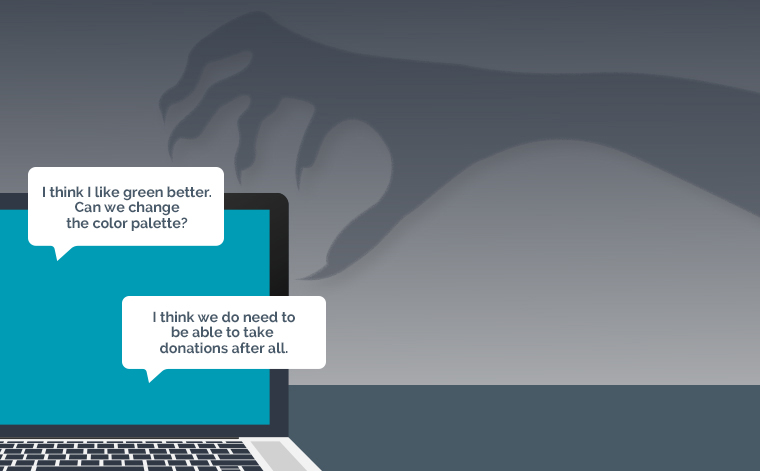Every website refresh project is a dynamic undertaking. Even when clients have a clear idea of what content they want to include and a good sense of how they want to change the look of their website, there are almost always changes that occur along the way.
It’s not surprising. None of us know what we don’t know. Web technologies are changing all the time, opening up new possibilities. As businesses evolve, most change up how they interact with customers online. And, once the redesign project kicks off, teams are often inspired to say more, do more, and offer more so the new website will serve clients better and longer. Which, of course, can lead to a website with more capability than originally anticipated – along with an extended scope, timeline, and budget.
Scope creep happens! But there are some steps you can take to keep it in check. Here are some ways to overcome website refresh scope creep:
- Look for Inspiration First: If it’s been a while since you’ve updated your website, take time sooner rather than later to see what others are doing. Find websites within and beyond your industry that inspire your team – with their page layout, use of white space, content organization, user experience, and/or interesting features.
By noticing what others are doing now, you’ll do a better job of capturing what you’d like to do on your next site. And you’ll minimize disruptive requests for new features after project priorities are established and the design is approved.
- Designate a Primary Point of Contact: Though you may have multiple stakeholders who provide input and feedback, select one person who has information about your organization and the website. Your primary point of contact should be the one to complete the web redesign questionnaire for your organization, consolidate input from your team, and be the final decision-maker.
This move will help you secure agreement on project scope before design and development begin. A primary point of contact will be able to clearly communicate the needs and wishes for your new website.
- Check Your Web Host: A website refresh is a great time to take a closer look at your web hosting service and its capabilities. Are you signed up for the right level of service for your web traffic? Does your web host provide the security you need? Do they make backups of your website and are they able to help you quickly when your site has an issue? Do they support the platform you are using to build your site?
If you expect to change the web hosting plan or platform you have now, build that change into your budget (both money and time). Or, if you’re not sure whether you’ll need to change your host, include a consultation and recommendation as part of the refresh project. Your website experts can recommend options that fit with your needs and resources.
- Understand Your Integrations: These days, most websites have integrations with third party services. Blogs, social media, email, PayPal, calendars, job application services…and so much more. Before you start a website refresh, check with your technical team to understand and assess your current and planned integration points. Not all integrations work on all platforms, so be open to finding new solutions.
By reviewing the hosting and server information for your integrated services, you’ll help avoid unnecessary technical support costs or delays.
- Plan for (Great) Website Copy: Many of our clients start website projects with an intention that their team will update or write new copy for the site, but then time or resource constraints slow things down. Others feel comfortable writing information that’s accurate, but not writing “on brand” or in a voice that’s inviting for web visitors. Creative calls to action often get missed altogether. If you know that your team can’t do it all, plan now to ask for help where you need it.
Often, having an outside writer or someone who can provide heavy edits to your draft web copy is just the right complement to your expertise.
- Gather Inspiring Photos and Images: Photos can make or break a website. Poor-quality photos can drag down a beautiful design. And beautiful photos can carry the first (and second) great impression of a website – even when the copy is lacking. Gather the photos and images you have now; look at them with a critical eye, to see if they truly shine.
If you don’t (yet) have great photos, consider scheduling a photoshoot with a professional photographer who can help you, your team, and your business look its best. The photoshoot can involve headshots of executives, capture team members at work, or bring to life the products or services you provide.
- Secure a Web Maintenance Plan. The “care and feeding” of your website is just as important as the refresh. We have seen too many instances of great websites getting stale quickly because information doesn’t change. Or worse, the sites experience malware infiltration. If you don’t have a maintenance plan with updates, offsite backups, and malware detection and protection in place, you are taking a very bold risk.
Optimize your visitors’ experience, support search engine rankings, and avoid or minimize the disruption of a security breach by putting your web maintenance plan in place now. Before you need it. (You’ll be glad you did!)
A website refresh is a big deal. We’ve helped clients through enough of these that we are able to highlight some of the sticking points we see repeatedly. By thinking about and planning for these “not uncommon” scope creep items now, you can approach your website refresh with confidence, creativity, and ease.
Is it time for your website refresh? Let us know! We’d love to help you bring your plan to life!
– Elizabeth Doubleday, Marketing Strategist & insight180 Team

